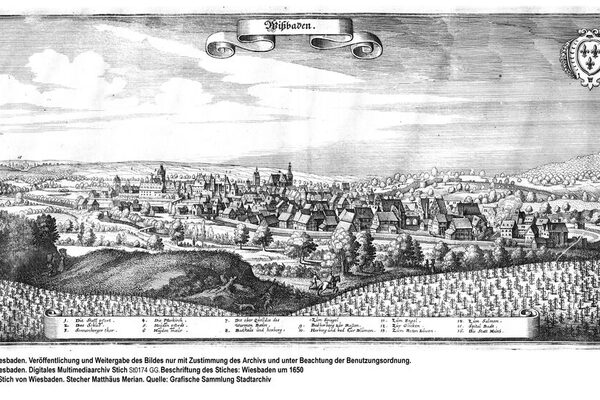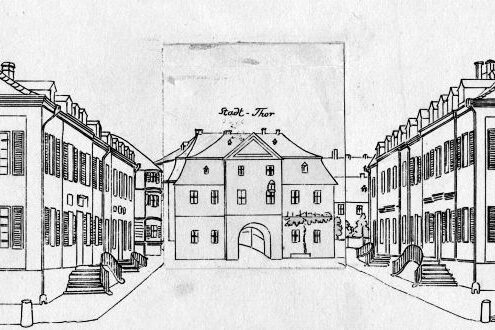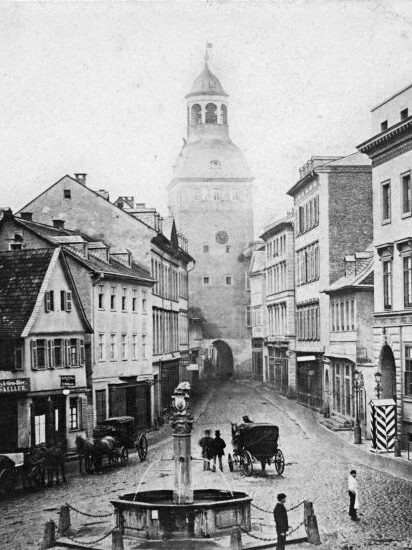City gates
Various city gates have provided access to the inner city since the Middle Ages. Important traffic routes crossed at the Mainz Gate in Kirchgasse, the main gate to the suburbs.
The Wiesbaden city wall was pierced by seven city gates: the Mainz Gate, the Lower Gate, the Upper Gate, the Dull Gate, the Pagan Gate, the New Gate and the Sonnenberg Gate. The Mainzer Pforte in the Kirchgasse, around 90 m south-southwest of the Mauritiuskirche, was the main entrance to the town or suburb. This town gate secured the mouth of important traffic routes from Mainz, from the Rheingau, from Mosbach-Biebrich, from Schierstein and from the Aar. First mentioned in 1437, an important customs post was located here by 1458 at the latest, which was protected by the court of the "Nobles of Wiesbaden". The Mainz Gate consisted of an outer and inner gate with a tower. On the bridge that connected the two was the municipal forge and the municipal weighing house with the scales. There was a side gate for pedestrians. In 1514, this gate was additionally secured by the construction of a bulwark with a battering ram.
When Prince Georg August Samuel von Nassau-Idstein had the Neugasse built at the end of the 17th century to accommodate the main traffic in future, the Mainz Gate lost its importance. Instead, the New Gate was built at the lower end of Neugasse in 1691/93, which was equipped with a barrier and a tower with a prison. The tower was directly adjacent to the orphanage; a bridge spanned the moat in front of it. The New Gate was demolished at the beginning of the 19th century as part of the construction of Friedrichstraße; the Mainz Gate, on the other hand, was closed as early as 1704.
The Niederpforte, first mentioned in 1363, was located where today the Mauergasse leads into Marktstraße and led into the area of the town proper. It protected the drawbridge that crossed the moat at this point and consisted of an inner and an outer gate. Between the two gates was a bridge with six arches mentioned in 1503. From 1517 onwards, the Niederpforte appeared as the city gate. After the closure of the Mainz Gate on Kirchgasse, its name was transferred to the Niederpforte, as traffic with Mainz now passed through it. A drawing by the librarian Helfrich Bernhard Hundeshagen gives a vivid impression of its appearance. The building was about 15 m long and 7 m wide; a cowshed and a pigsty adjoined it. On the upper floor was the shepherd's dwelling, which was moved to the town hall when it was demolished. The two-storey tower crowning the gate, known as the Bürgerturm, fell in 1803 to provide building material for the new buildings in front of the Mainzer Tor. In 1813, the entire building was auctioned off to the highest bidder.
The Oberpforte spanned the Marktstraße. Its tower carried the storm bell, which is why it was first referred to as a bell house or tower in 1457. From the beginning of the 16th century, the town clock was located here, which is why the name clock tower was coined for this gate from 1524. Two keepers looked after the clock, and clockmakers from Mainz and other places came here every year to maintain it. The Oberpforte was severely damaged in the town fire of 1547 and the bell and clock were destroyed. Just one year later, a new clock with a painted dial replaced the old one, and a new bell house, a new bell and a new town banner, which was apparently kept here, were also purchased. When the Oberpforte lost its function as part of the town fortifications when the town was incorporated into the wall in 1508, the town archives were housed here. In 1873, the clock tower was taken down as the last relic of the medieval town fortifications.
The so-called Stumpfe Pforte (Blunt Gate), so called because it was the only gate without a tower, was located on Michelsberg at the current junction of Coulinstraße. Mentioned in 1477, it served as a passageway for pedestrians. It was quite narrow, with only a footbridge leading over the moat. It was only converted into a gateway in 1704, but by 1781 it was in danger of collapsing. In 1817, the Stumpfe Pforte was auctioned off for demolition.
The Pagan Gate stood at right angles to the Pagan Wall and leaned against its northern side, at the place now known as "Am Römertor". It took up the path coming from Wehen and Neuhof, which ran along Platterstrasse, then Kastellstrasse and lower Adlerstrasse towards the town. This is why it was also called the "Weher Pforte" at times. In 1524, it was replaced by a two-gate complex. The inner gate had a tower structure which served as a prison for two people in 1811. In 1713/24 it was closed except for a passage for pedestrians. In 1828, the Heidnische Pforte was also auctioned off for demolition.
The Sonnenberger Pforte led from the Sauerland towards Sonnenberg and was located on today's lower Webergasse. It was first mentioned in 1503. It consisted of an inner gate with a gate tower, which was based on the "Zum Weißen Roß" bathhouse, and an outer gate with a barrier in front of it. In the early 18th century, the gate was moved to the east in connection with the construction of the town wall. The Sonnenberger Tor was closed in 1819 and taken down in 1821.
Literature
Wiesbaden in the Middle Ages. History of the City of Wiesbaden 2, Wiesbaden 1980.


